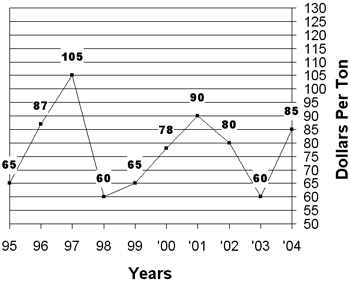Production Update:
Stand Replacement: The decision to replace alfalfa stands
is based on stand establishment costs, opportunities in other crops, hay
price, and yield of the alfalfa stand in question. Historical yields for
the farm can provide a good idea whether or not a stand should be replaced.
A stand should be replaced if plant density is less than 4 to 6 plants
per square foot or if the number of stems is less than 40 per square foot.
Optimum plant density can be considerably higher if the plants are not
distributed uniformly. Renovating alfalfa stands by overseeding with alfalfa
is rarely effective except in relatively large bare sports. Delay seeding
alfalfa into a field previously in alfalfa by 2 to 4 weeks to avoid autotoxicity.
Insect Management: Cowpea
aphid (picture)
can be a pest of seedling alfalfa. Cowpea aphid is the only black aphid
found in our alfalfa. When stands of alfalfa become heavily infested with
cowpea aphid, an insecticide treatment may be warranted to prevent stunting
and leaf drop, and to prevent honeydew and sooty mold contamination. Treatment
thresholds have not been established for cowpea aphid on alfalfa.
Weed Control: Although the mode of action and chemical
composition of the grass herbicides, Poast, Select, Fusilade, Assure and
others, are very similar, their activity on certain grasses varies. Sprangletop,
for instance, is not controlled by Poast but is by Select.
| Market Summary |
High
|
Low
|
Average
|
Off grade
|
| Past 2 Weeks ( 2004) |
90
|
80
|
85
|
70-80
|
| Last Year ( 2003) |
65
|
55
|
60
|
50-55
|
10 Year Summary (Sept 3, to Sept. 20, 1995-2004):

Issued in furtherance of Cooperative Extension work, acts of May 8 and June 30, 1914, in cooperation with the U.S. Department of Agriculture, James A. Christenson, Director Cooperative Extension, College of Agriculture and Life Sciences, The University of Arizona.
The University of Arizona is an equal opportunity, affirmative action institution. The University does not discriminate on the basis of race, color, religion, sex, national origin, age, disability, veteran status, or sexual orientation in its programs and activities.
Any products, services, or organizations that are
mentioned, shown, or indirectly implied in this web document do not imply
endorsement by The University of Arizona.
Information provided by:
Barry Tickes, btickes@ag.arizona.edu Extension Agent, Yuma County
Michael Ottman, mottman@ag.arizona.edu Agronomy Specialist
College of Agriculture, The University of Arizona.
Eric Natwick, etnatwick@ucdavis.edu UCCE Imperial County - Farm Advisor
University of California, Davis, CA.
Forages: Crop Mgmt | Soil Mgmt | Irrigation | Alfalfa Reports | Insects | Diseases | Weeds | Pesticides
Home | Other Crops | Forages
For more Arizona Production Ag Information:
Home | Cotton | Veggies| Forages | Grains | Citrus | Crop x Crop | Insects | Diseases| Weeds | Pesticides | News | Weather | Research | Photos | Contacts | General Info. | Site Map
Copyright © 2001 University of Arizona,
College of Agriculture and Life Sciences
Webmaster: Al Fournier (fournier@ag.arizona.edu)